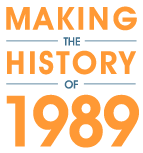Primary Sources
Browse Items
Czechoslovak Ministry of Interior Memorandum, "Information Regarding the Development of the Security Situation During the Period of the 17 November Anniversary"
Despite the growing pressure for change in the autumn of 1989, Czechoslovak officials did not automatically view the November 17 commemoration as a major security risk. Unlike the other politically-charged anniversaries that had increasingly become beacons for protest, this date did not ideologically threaten communism. In fact, it had been officially recognized since World War II and in 1989,….
Memorandum of Conversation Between Egon Krenz, Secretary General of the Socialist Unity Party and Mikhail S. Gorbachev
The new Secretary General of East Germany, Egon Krenz, traveled to Moscow on November 1, 1989 to meet in person with Gorbachev and assess the situation in East Germany and discuss possible paths forward. Throughout the lengthy meeting, Krenz and Gorbachev spoke openly about the challenges that now faced the GDR. Gorbachev, for the most part, remained hopeful that the new GDR leadership could….
Czechoslovak Ministry of Interior Memorandum, The Security Situation in the CSSR in the Period Before 28 October
October 28 holds a special place on the Czechoslovak political calendar because on that day the First Czechoslovak Republic was established in 1918. This liberal bourgeois state, symbolized by its founding father and President Tomas Garrigue Masaryk, was a powerful counter-example to socialist Czechoslovakia and a magnet for anti-communist protest. This 1989 report from the Ministry of the….
Czechoslovak Ministry of Interior Memorandum, Information on the Security Situation in the CSSR
In October 1989, the situation was growing dire for the Czechoslovak communists. Increasing unrest and change in other Eastern Bloc countries was quickly isolating conservatives and emboldening the domestic opposition. In the analysis presented here, Federal Minister of the Interior Frantisek Kincl details a number of domestic security threats. The first was the opposition's increased level of….
US Mission cable, Summary of Berlin Press End of the Cold War
The press excerpts gathered here by the U.S. Embassy in East Berlin and transmitted to offices in Washington, Bonn, Brussels, and Tokyo reflect the growing urgency of the situation in East Berlin. This press report comes just days after two of the largest days of demonstrations in Berlin, Leipzig, and elsewhere on October 7 and 9, 1989.
West Berlin's governing mayor, Walter Momper….
National Intelligence Council Memorandum, Status of Soviet Unilateral Withdrawals
In December 1988, Soviet leader Mikhail Gorbachev delivered what he called a “watershed” address at the United Nations, announcing that he planned unilaterally to reduce Soviet military forces by 500,000, cut conventional armaments massively, and withdraw substantial numbers of armaments and troops from Eastern European countries. Even with the proposed cutbacks, Soviet conventional forces….
National Security Directive 23: United States Relations with the Soviet Union
As President George H. W. Bush took office in January 1989, factions within his administration disagreed concerning the approach to take with regard to US-Soviet relations. In December 1988, Gorbachev had delivered what he called a “watershed” address at the United Nations, announcing that he planned unilaterally to reduce Soviet military forces by 500,000, cut conventional armaments….
Czechoslovak Secret Police Memorandum, "Information on the Security Situation . . "
This Secret Police (StB) memorandum from 21 August details the plans of independent and opposition groups to commemorate the politically-sensitive anniversary of the 1968 Warsaw Pact invasion, and the police's "extraordinary security measures" to prevent the commemorations from taking place. The memorandum presents a striking picture of the scale and diversity of the repressive measures….
Czechoslovak Secret Police Memorandum, "Information Regarding the Situation in the CSSR"
As a result of the intensifying public demonstrations in the first half of 1989, the Czechoslovak Communist Party increased its surveillance and suppression of independent and opposition groups, particularly in anticipation of politically-charged anniversaries. This Secret Police (StB) memorandum details preparations by various groups to commemorate the August 21st anniversary of the 1968….
National Securty Directive in Response to Polish Roundtable Agreement
Officials in the United States watched closely the historic roundtable talks that took place between Communist Party leaders and the opposition in Poland from February to April 1989. During these sessions, participants agreed to numerous changes, including the initiation of economic reform measures. In response to the roundtable agreements that focused on Poland's economy specifically, U.S.….
Religious Freedom in the Soviet Union
By the summer of 1988, Mikhail Gorbachev's reform policies glasnost' (openness) and perestroika (restructuring) had begun to change the political landscape of the Soviet Union. The U.S. and Soviet Union had made considerable progress in limiting arms build-up through a series of negotiations. However, when President Ronald Reagan visited Moscow in the summer of 1988 for a political summit, the….
Conversations between the Catholic Church and the Polish Government
Poland was unique among Warsaw Pact countries in the degree of influence retained by the Catholic Church. But the church was also viewed as a powerful competitor to the state, and its leaders were among the first to be monitored and harassed during periods of social unrest. It is for this reason that the meeting transcribed in this document is so remarkable: Church officials proposed church….
Changes in Eastern Europe and Their Impact on the USSR
This February 1989 report by the Bogomolov Commission analyzes the current situation in Eastern Europe for Alexander Yakovlev, key foreign policy advisor to Mikhail Gorbachev. The Bogomolov Commission was the largest Soviet think tank conducting research on the East European countries. This document can be compared with the memorandum by the International Department of the CC CPSU (document….
